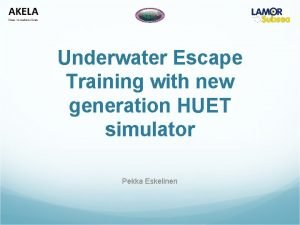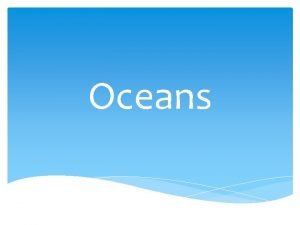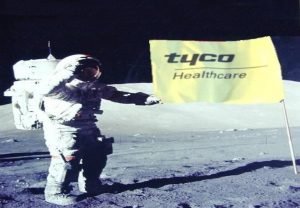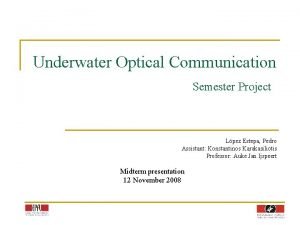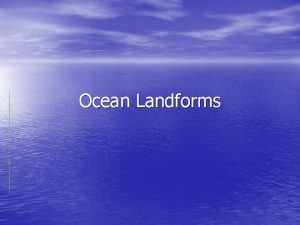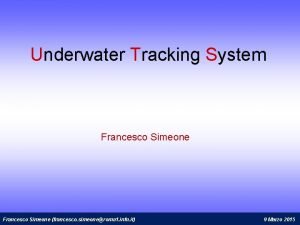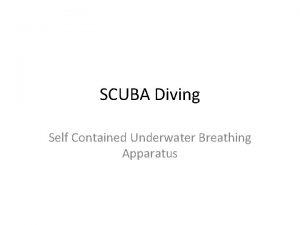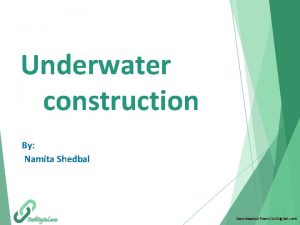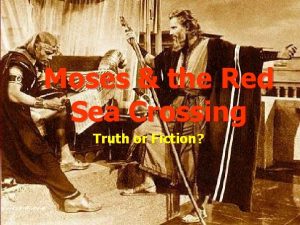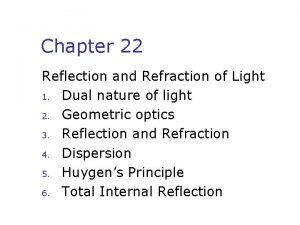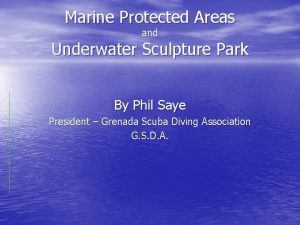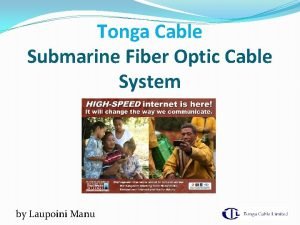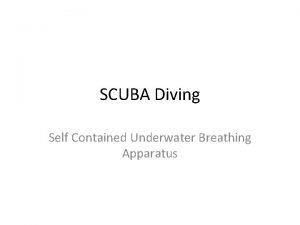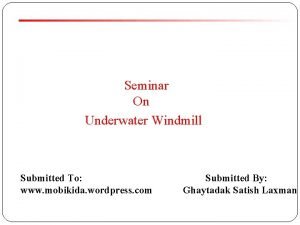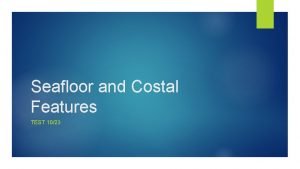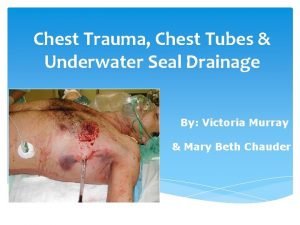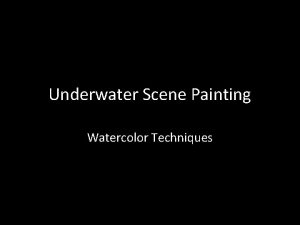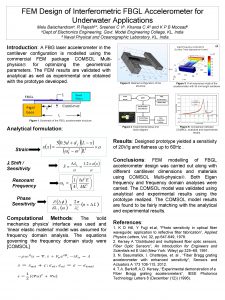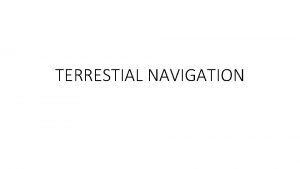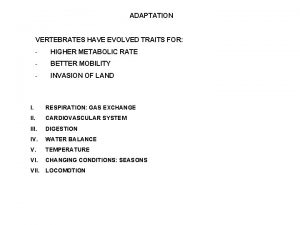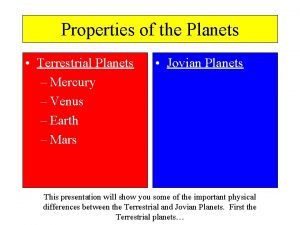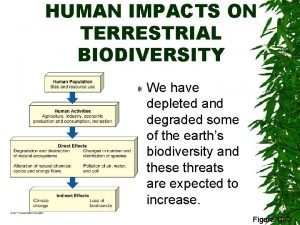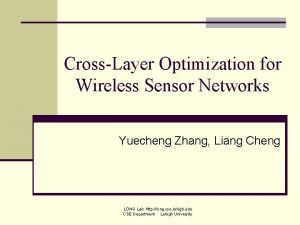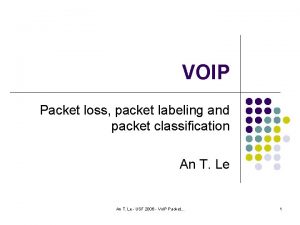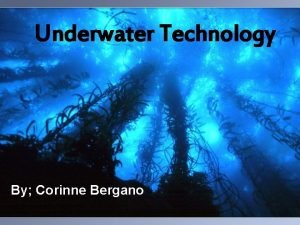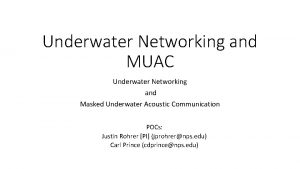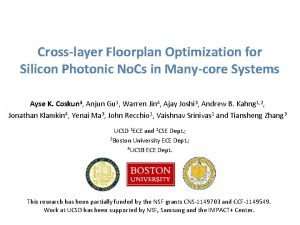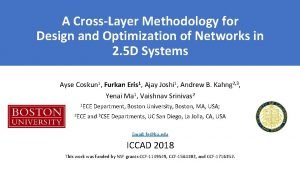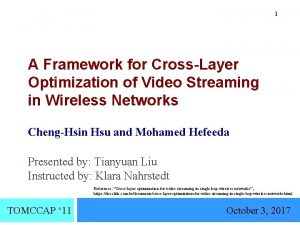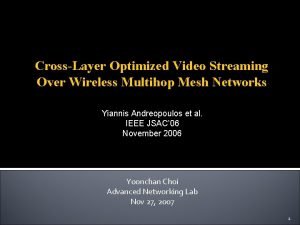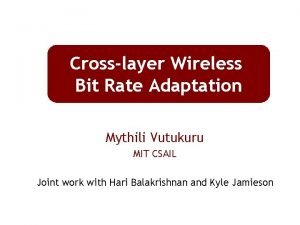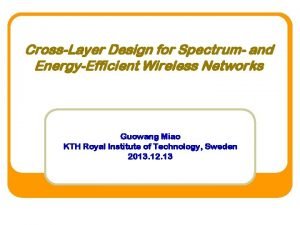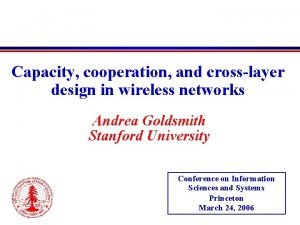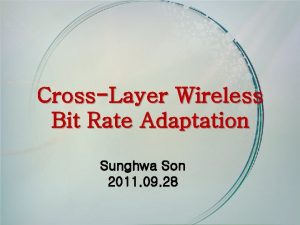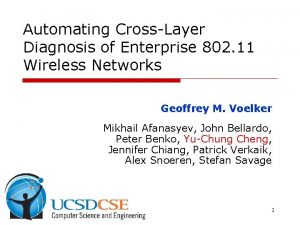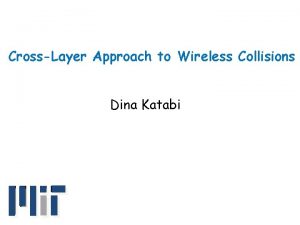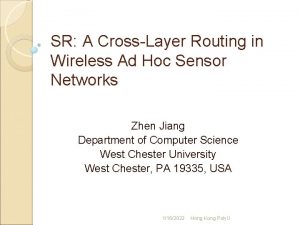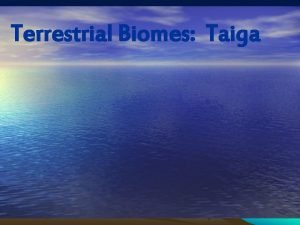Crosslayer Packet Size Optimization for Wireless Terrestrial Underwater





![Related Work p Voice Packet Size between UMTS-to-PSTN [1] n p Single hop communication Related Work p Voice Packet Size between UMTS-to-PSTN [1] n p Single hop communication](https://slidetodoc.com/presentation_image_h/1ed4ec0ad8c502b8706a21fe0cf32b12/image-6.jpg)





![Packet Size Optimization Framework p Channel model n Log-normal channel model [5] p p Packet Size Optimization Framework p Channel model n Log-normal channel model [5] p p](https://slidetodoc.com/presentation_image_h/1ed4ec0ad8c502b8706a21fe0cf32b12/image-12.jpg)
![Packet Size Optimization Framework p End-to-End energy consumption [6] n n n Database Laboratory Packet Size Optimization Framework p End-to-End energy consumption [6] n n n Database Laboratory](https://slidetodoc.com/presentation_image_h/1ed4ec0ad8c502b8706a21fe0cf32b12/image-13.jpg)




![Optimization Results p Very long packet sizes have problem [7] Database Laboratory 18 Optimization Results p Very long packet sizes have problem [7] Database Laboratory 18](https://slidetodoc.com/presentation_image_h/1ed4ec0ad8c502b8706a21fe0cf32b12/image-18.jpg)




















![Reference p p p p p [1] F. Poppe, D. De Vleeschauwer, G. H. Reference p p p p p [1] F. Poppe, D. De Vleeschauwer, G. H.](https://slidetodoc.com/presentation_image_h/1ed4ec0ad8c502b8706a21fe0cf32b12/image-39.jpg)
- Slides: 39

Cross-layer Packet Size Optimization for Wireless Terrestrial, Underwater, and Underground Sensor Networks IEEE INFOCOM 2008 Mehmet C. Vuran and Ian F. Akyildiz Database Lab. Soo Hyung Kim

Contents Introduction p Related Work p Factors Affecting the Packet Size p Packet Size Optimization Framework p Optimization Results p Packet Size Optimization in Wireless Underwater and Underground Sensor Networks p Conclusion p Database Laboratory 2

Introduction p Traditional approach n Point-to-point link p n Successful and efficient transmission Cannot be captured multi-hop, broadcast nature serial cable, phone line Node Database Laboratory 3

Introduction p Multi-hop WSN n n n p Routes established Existence of neighbor nodes Wireless channel and error control technique Nature of WSN n n n Terrestrial areas Underwater (UW-ASN) Underground (WUSN) Database Laboratory 4

Introduction p Cross-layer solution for packet size optimization n p The effects of multi-hop routing The broadcast nature of the physical wireless channel The effects of error control techniques Three objective functions n n n Packet throughput Energy consumption Resource utilization Database Laboratory 5
![Related Work p Voice Packet Size between UMTStoPSTN 1 n p Single hop communication Related Work p Voice Packet Size between UMTS-to-PSTN [1] n p Single hop communication](https://slidetodoc.com/presentation_image_h/1ed4ec0ad8c502b8706a21fe0cf32b12/image-6.jpg)
Related Work p Voice Packet Size between UMTS-to-PSTN [1] n p Single hop communication Improving Wireless Link [2] n Variable packet size p p Properties of the wireless channel Energy efficiency [3] n n n Most relevant work Effects of error correction on energy efficiency Energy channel model is based on single hop Database Laboratory 6

Factors Affecting the Packet Size p Factors(focus on energy consumption) n Transmit a packet and Reliability of the network p Small packet size § increase reliability § inefficient transmission p Longer packet size § provide error resiliency § increased energy consumption n Collision p Longer packet size § increase the collision rate Database Laboratory 7

Factors Affecting the Packet Size p Carrier sense mechanism n n p Successful carrier sense No collision transmission Formulation(from [4]) Probability of successful carrier sense Probability of sensing the channel free Probability of no collision Overall traffic rate Database Laboratory 8

Factors Affecting the Packet Size p Total generated packet rate (pkts/s) n p p p b : average sampling rate Ld : packet payload i : node n n p M : number of nodes in the transmission rage n p MAC Failure rate Database Laboratory 9

Packet Size Optimization Framework p Three objective function n Packet throughput n Energy per useful bit n Resource utilization p p Database Laboratory Ld : payload length PER : end-to-end packet error rate T : end-to-end latency E : end-to-end energy consumption 10

Packet Size Optimization Framework p Channel-aware algorithm n p SNR ( ) n p Signal to noise ratio Medium access n p Determine next hop using SNR RTS-CTS-DATA exchange Error correction n n ACK and ARQ FEC code p (n, k, t) - n: block length, k: payload length, t: error correcting capability in bits Database Laboratory 11
![Packet Size Optimization Framework p Channel model n Lognormal channel model 5 p p Packet Size Optimization Framework p Channel model n Log-normal channel model [5] p p](https://slidetodoc.com/presentation_image_h/1ed4ec0ad8c502b8706a21fe0cf32b12/image-12.jpg)
Packet Size Optimization Framework p Channel model n Log-normal channel model [5] p p Database Laboratory 12
![Packet Size Optimization Framework p EndtoEnd energy consumption 6 n n n Database Laboratory Packet Size Optimization Framework p End-to-End energy consumption [6] n n n Database Laboratory](https://slidetodoc.com/presentation_image_h/1ed4ec0ad8c502b8706a21fe0cf32b12/image-13.jpg)
Packet Size Optimization Framework p End-to-End energy consumption [6] n n n Database Laboratory 13

Packet Size Optimization Framework p p Etx for ARQ and FEC p Similar approach for , Database Laboratory , , 14

Optimization Results p Energy consumption n n p Packet size SNR threshold Packet size optimization is affected by the routing decisions. Database Laboratory 15

Optimization Results Database Laboratory 16

Optimization Results p Using MATLAB Database Laboratory 17
![Optimization Results p Very long packet sizes have problem 7 Database Laboratory 18 Optimization Results p Very long packet sizes have problem [7] Database Laboratory 18](https://slidetodoc.com/presentation_image_h/1ed4ec0ad8c502b8706a21fe0cf32b12/image-18.jpg)
Optimization Results p Very long packet sizes have problem [7] Database Laboratory 18

Optimization Results p Certain WSN application n n End-to-End latency Reliability constraints Database Laboratory 19

Optimization Results Database Laboratory 20

Packet Size Optimization in Wireless Underwater and Underground Sensor Networks p Underwater Channel Model n Urick path loss formula [8] p n Signal level p n SNR of channel p n Bit error rate p where Database Laboratory 21

Packet Size Optimization in Wireless Underwater and Underground Sensor Networks p Underwater Channel Model n 2 -path Rayleigh model Direct path signal p Surface reflected path signal p n Bit error rate p n Combination of these signals 2 -path Rayleigh model Not closed form expression for SNR distribution p Performed simulation to find these values p Database Laboratory 22

Packet Size Optimization in Wireless Underwater and Underground Sensor Networks p Underground Channel Model [9] n n n 2 -path location-based Rayleigh fading channel model VWC(volumetric water content) of the soil Total path loss p n Bit error rate p n SNR p Database Laboratory 23

Packet Size Optimization in Wireless Underwater and Underground Sensor Networks p Results n Three different optimization problems p n , , Underwater p Deep water network § Two-ray underwater channel model p Shallow water network § Reflections from the sea surface n Underground Channel model presented in previous page p Effects of volumetric water content(VWC) p Database Laboratory 24

Packet Size Optimization in Wireless Underwater and Underground Sensor Networks p Wireless Underwater Sensor Networks n Deep Water Environment Database Laboratory 25

Packet Size Optimization in Wireless Underwater and Underground Sensor Networks p Wireless Underwater Sensor Networks n Shallow Water Environment Database Laboratory 26

Packet Size Optimization in Wireless Underwater and Underground Sensor Networks p Wireless Underwater Sensor Networks n Optimum Energy Consumption Database Laboratory 27

Packet Size Optimization in Wireless Underwater and Underground Sensor Networks p Wireless Underwater Sensor Networks n Optimum Packet Throughput Database Laboratory 28

Packet Size Optimization in Wireless Underwater and Underground Sensor Networks p Wireless Underwater Sensor Networks n Optimum Resource Utilization Database Laboratory 29

Packet Size Optimization in Wireless Underwater and Underground Sensor Networks p Wireless Underwater Sensor Networks n Optimum Packet Size for Database Laboratory 30

Packet Size Optimization in Wireless Underwater and Underground Sensor Networks p Wireless Underwater Sensor Networks n Optimum Energy Consumption Database Laboratory 31

Packet Size Optimization in Wireless Underwater and Underground Sensor Networks p Wireless Underground Sensor Networks n Optimum Packet Size Database Laboratory 32

Packet Size Optimization in Wireless Underwater and Underground Sensor Networks p Wireless Underground Sensor Networks n Optimum Energy Consumption Database Laboratory 33

Packet Size Optimization in Wireless Underwater and Underground Sensor Networks p Wireless Underground Sensor Networks n Optimum Packet Size for Database Laboratory 34

Packet Size Optimization in Wireless Underwater and Underground Sensor Networks p Wireless Underground Sensor Networks n Optimum Energy Consumption Database Laboratory 35

Packet Size Optimization in Wireless Underwater and Underground Sensor Networks p Wireless Underground Sensor Networks n Optimum Packet Throughput Database Laboratory 36

Conclusion Packet size optimization for wireless terrestrial, underwater, and underground sensor networks p Framework p n n p Medium access collisions Routing decisions Performance metrics n n n Throughput Energy consumption Packet error rate Environment Terrestrial 152 250 25 Underwater(Deep) 668 439 16 Underwater(Shallow) 1232 1003 236 Underground(vwc=5% ) 864 502 23 Database Laboratory 37

Thank you!! Database Laboratory
![Reference p p p p p 1 F Poppe D De Vleeschauwer G H Reference p p p p p [1] F. Poppe, D. De Vleeschauwer, G. H.](https://slidetodoc.com/presentation_image_h/1ed4ec0ad8c502b8706a21fe0cf32b12/image-39.jpg)
Reference p p p p p [1] F. Poppe, D. De Vleeschauwer, G. H. Petit, “Choosing the UMTS airinterface parameters, the voice packet size and the dejitteringdelay for a voice-over-IP call between a UMTS and a PSTN party, ”in Proc. IEEE INFOCOM 2001, vol. 2, pp. 805 -814, April 2001. [2] P. Lettieri, M. B. Srivastava, “Adaptive frame length control for improving wireless link throughput, range, and energy efficiency, ” in Proc. IEEE INFOCOM 1998, vol. 2, pp. 564 -571, April 1998. [3] Y. Sankarasubramaniam, I. F. Akyildiz, S. W. Mc. Laughlin, “Energy efficiency based packet size optimization in wireless sensor networks, ” in Proc. IEEE Internal Workshop on Sensor Network Protocols and Applications, pp. 1 8, 2003. [4] K. Schwieger, A. Kumar, G. Fettweis, “On the Impact of the Physical Layer on Energy Consumption in Sensor Networks, ” in Proc. EWSN ’ 05, pp. 13 - 24, Feb. 2005. [5] M. Zuniga, B. Krishnamachari, “Analyzing the Transitional Region in Low Power Wireless Links, ” in Proc. IEEE SECON ’ 04, pp. 517 – 526, Oct. 2004. [6] M. C. Vuran and I. F. Akyildiz, “Cross Layer Analysis of Error Control in Wireless Sensor Networks, ” in Proc. IEEE SECON ’ 06, Reston, VA, September 2006. [7] IEEE 802. 15. 4, “Wireless Medium Access Control (MAC) and Physical Layer (PHY) Specifications for Low-Rate Wireless Personal Area Networks (LR-WPANs), ” October 2003. [8] I. F. Akyildiz, D. Pompili, and T. Melodia, “Underwater Acoustic Sensor Networks: Research Challenges, ” Ad Hoc Networks Journal (Elsevier), vol. 3, no. 3, pp. 257 -279, March 2005. [9] L. Li, M. C. Vuran, and I. F. Akyildiz, “Characteristics of Underground Channel for Wireless Underground Sensor Networks, ” in Proc. Med-Hoc- Net ’ 07, Corfu, Greece, June 2007. Database Laboratory 39
 What are wireless devices and the wireless revolution
What are wireless devices and the wireless revolution Const char *s
Const char *s Moderately coarse powder
Moderately coarse powder Eg&g underwater camera 1960
Eg&g underwater camera 1960 Huet simulator
Huet simulator Padi quiz 3 answers
Padi quiz 3 answers Underwater habitat
Underwater habitat Thora seal instructions
Thora seal instructions Cucumber zoo
Cucumber zoo Underwater optical control
Underwater optical control Ice age scrat underwater
Ice age scrat underwater Ccc underwater engineering
Ccc underwater engineering Ocean
Ocean Underwater windmill seminar report
Underwater windmill seminar report Underwater tracking systems
Underwater tracking systems Self contained underwater breathing apparatus
Self contained underwater breathing apparatus Where did moses cross the red sea map
Where did moses cross the red sea map Underwater construction techniques
Underwater construction techniques Nuweiba moses
Nuweiba moses An underwater scuba diver sees the sun
An underwater scuba diver sees the sun Underwater sculpture
Underwater sculpture Tonga fiber optic cable
Tonga fiber optic cable Self contained underwater breathing apparatus
Self contained underwater breathing apparatus Underwater windmill ppt
Underwater windmill ppt Abyssal plains examples
Abyssal plains examples Dry vs wet suction chest tube
Dry vs wet suction chest tube Underwater frisbee
Underwater frisbee How to paint underwater scene watercolor
How to paint underwater scene watercolor Lemurya
Lemurya Underwater accelerometer
Underwater accelerometer Terrestrial navigation meaning
Terrestrial navigation meaning Terrestrial life
Terrestrial life Respiration in terrestrial animals
Respiration in terrestrial animals Terrestrial planet
Terrestrial planet Inner planets and outer planets
Inner planets and outer planets My very excited mother planets
My very excited mother planets Impacts of wildlife trade on terrestrial biodiversity
Impacts of wildlife trade on terrestrial biodiversity Scope of hydroponics
Scope of hydroponics Frog life cycle
Frog life cycle Taiga food chain examples
Taiga food chain examples




